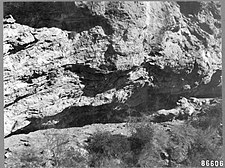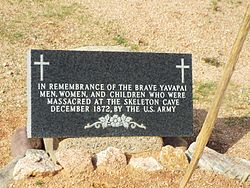Yavapai Wars
| Yavapai Wars | |||||||
|---|---|---|---|---|---|---|---|
| Part of the Apache Wars | |||||||
 Skeleton Cave | |||||||
| |||||||
| Belligerents | |||||||
|
| |||||||
| Commanders and leaders | |||||||
|
Pauline Weaver George Crook Charles King |
Delshay Nanni-chaddi† | ||||||
| Casualties and losses | |||||||
| 741 to 1,075 killed directly, Yavapai population declined by 4,000 to over 5,500 overall from various causes[note 3] | |||||||
The Yavapai Wars, or the Tonto Wars, were a series of
Settler–Yavapai conflict
With the Mohave people's power greatly diminished, Tolkepaya saw that they needed to make new alliances to protect their safety. In April 1863, Quashackama, a well-known Tolkepaya, met with Arizona Territory superintendent of Indian affairs Charles Poston, along with representatives of the Pimas, Mohaves, Maricopas and Chemehuevis, at Fort Yuma, to sign an agreement intended "to promote the commerce in safety between the before mentioned tribes and the Americans." However, the agreement was not an official treaty, so therefore not legally binding in any way.[6]
Despite this, the growing numbers of settlers (very quickly outnumbering Yavapai) began to call for the government to do something about the people occupying the land that they wanted to occupy and exploit themselves. The editor of a local newspaper, the Arizona Miner, said "Extermination is our only hope, and the sooner it is accomplished the better."[7]
Early in January 1864, the Yavapai raided a number of ranches that supplied cattle to the miners in the Prescott and Agua Fria area. As a result of this and a series of recent killings, a preemptive attack was organized to discourage future depredations. Therefore, a group of well-armed volunteers were quickly outfitted with King S. Woolsey as their leader. Their mission was to track the raiding party back to their rancheria. What followed was an infamous footnote in Arizona history known today as the Bloody Tanks incident.[citation needed]
According to Braatz, "In December 1864, soldiers from Fort Whipple attacked two nearby Yavapé camps, killing 14 and wounding seven." The following month, Fort Whipple soldiers attacked another group of Yavapé, this time killing twenty-eight people, including their headman, Hoseckrua. Included in the group were employees of Prescott's US Indian agent John Dunn.[citation needed]
Reservation wars

In 1864,
Not long after, in retaliation for the murder of a Pai headman by Americans, a group of Pai attacked some wagon trains, and closed the road between Prescott and Fort Mohave to all traffic. In response, the US Army declared all Indians in lands beyond 75 miles (121 km) east of the Colorado River (the great majority of traditional Yavapai territory) to be "hostile" and "subject to extermination".[10]
On November 5, 1871, the ambush of the Wickenburg stage – the
Yavapai War
| Yavapai War | |||||||
|---|---|---|---|---|---|---|---|
| Part of the Yavapai Wars, Apache Wars | |||||||
 The rescue of Lieutenant Charles King by Sergeant Bernard Taylor during the battle at Sunset Pass in 1874. | |||||||
| |||||||
| Belligerents | |||||||
|
|
Apache | ||||||
| Commanders and leaders | |||||||
|
George Crook Charles King |
Delshay Nanni-chaddi † | ||||||
The Yavapai War, was an
In December 1872, Colonel
In 1925, a group of Yavapai from the Fort McDowell Reservation, along with a Maricopa County Sheriff, collected the bones from the cave, by then named Skeleton Cave, and interred them at the Fort McDowell cemetery.[14]
Exodus Day
In 1886, many Yavapai joined in campaigns by the US Army, as scouts, against
Notes
See also
References
- ^ Ojibwa. "The War Against the Yavapai". Native American Netroots.
- ^ ISBN 9781622336524. Archived from the originalon 2019-05-04.
- ^ a b Immanuel, Marc (21 April 2017). "The Forced Relocation of the Yavapai".
- ^ a b "The Apache War 1871–1873". www.onwar.com. Archived from the original on 23 June 2013.
- ^ a b "Yavapai–Apache Exodus Day". www.visitcampverde.com. Archived from the original on 28 September 2009.
- ^ Braatz, p. 87
- ^ Braatz, p. 89
- ^ Campbell, p. 104
- ^ Gifford, pp. 275–76
- ^ Braatz, pg. 92
- ^ "PBS – The West – Oliver Otis Howard". www.pbs.org.
- ^ Braatz, p. 138
- ^ "Survey of Historic Sites and Buildings". Archived from the original on 2014-07-29. Retrieved 2007-01-01.
- ^ Fenn, p. 12
- ^ Braatz, p. 3
- ^ Braatz, p. 88
- Braatz, Timothy (2003). Surviving conquest: a history of the Yavapai peoples. University of Nebraska Press. ISBN 0-8032-1331-X.
Sources
- Braatz, Timothy (2003). Surviving Conquest. University of Nebraska Press. ISBN 978-0-8032-2242-7.
- Campbell, Julie A. (1998). Studies in Arizona History. Tucson, Arizona: Arizona Historical Society. ISBN 0910037388
- Coffer, William E. (1982). Sipapu, the Story of the Indians of Arizona and New Mexico, Van Nostrand Reinhold, ISBN 0-442-21590-8.
- Fenn, Al, "The Story of Mickey Burns", Sun Valley Spur Shopper, September 30, 1971
- Fish, Paul R. and Fish, Suzanne K. (1977). Verde Valley Archaeology: Review & Prospective, Flagstaff: Museum of Northern Arizona, Anthropology research report #8
- Gifford, Edward (1936). Northeastern and Western Yavapai. Berkeley, California: University of California Press.
- Hoxie, Frederick E. (1996). Encyclopedia of North American Indians, Houghton Mifflin Books, ISBN 0-395-66921-9.
- Jones, Terry L. and Klar, Kathryn A. (2007). California Prehistory: Colonization, Culture, and Complexity, Rowman Altamira, ISBN 0-7591-0872-2.
- Kendall, Martha B. (1976). Selected Problems in Yavapai Syntax. New York: Garland Publishing, Inc., ISBN 0-8240-1969-5.
- Nelson Espeland, Wendy (1998). The Struggle for Water: Politics, Rationality, and Identity in the American Southwest, University of Chicago Press. ISBN 0-226-21793-0
- Pritzker, Harry (2000). A Native American Encyclopedia: History, Culture, and Peoples, Oxford University Press, ISBN 0-19-513877-5.
- Ruland Thorne, Kate; Rodda, Jeanette; Smith, Nancy R. (2005). Experience Jerome: The Moguls, Miners, and Mistresses of Cleopatra Hill, Primer Publishers, ISBN 0-935810-77-3.
- Salzmann, Zdenek and Salzmann, Joy M. (1997). Native Americans of the Southwest: The Serious Traveler's Introduction to Peoples and Places. Boulder, Colorado: Westview Press. ISBN 0-8133-2279-0
- Swanton, John Reed (1952). The Indian Tribes of North America, US Government Printing Office.
- University of California, Berkeley (1943). University of California Publications in Linguistics, University of California Press.
- Utley, Robert Marshall (1981). Frontiersmen in Blue: The United States Army and the Indian, 1848–1865, University of Nebraska Press, ISBN 0-8032-9550-2.
- Big Dry Wash Battlfield, Arizona at NPS
- Fort McDowell Yavapai Nation Archived 2009-04-19 at the Wayback Machine, history and culture
- Yavapai–Apache Nation, official site
- Yavapai Prescott Indian Tribe, official site
External links
 Media related to Yavapai Wars at Wikimedia Commons
Media related to Yavapai Wars at Wikimedia Commons
